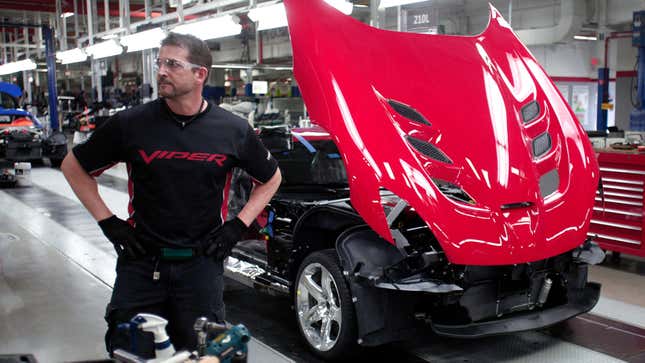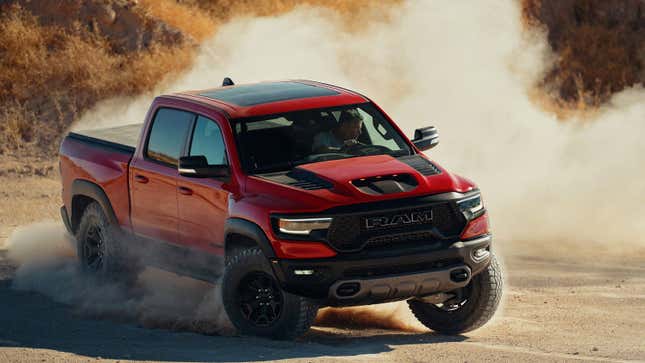
Nobody seems exactly sure what’s going on over at SRT, the purveyors of Hellcats, Demons and other vehicles that embarrass Satan. Earlier this week, Stellantis released an official statement that “all of the core elements of the SRT performance engineering team were integrated into Stellantis’ global engineering organization” — a move that the newly minted conglomerate said would broaden “high-performance-technology applications across a wider mix” of its product lines.
Still, with a recent corporate shakeup at the highest level, fans are worried that the rip-snorting muscle cars they love are in danger of disappearing. Seemingly in response, Ralph Gilles, one of Stellantis’ two global design directors and former head of SRT (when it was completely its own brand for a hot minute) took to Instagram on Thursday to assuage some fears:
So much controversy about the fate of SRT... I posted the official company statement below. I will add that we will keep imagining, developing new & compelling products worthy of the SRT badge for years to come. By being integrated into the core teams, the passionate & brilliant engineers behind the current SRT products will certainly influence the performance aspects of a broader spectrum of products. In fact as an example while there isn’t any outright SRT badging on them, the latest RAM TRX & 392 Wrangler launching this year were a result of RAM & Jeep calling on those very team members to help and work with the core teams... to great results.
While Gilles’ line about integrating the SRT engineering team within Stellantis’ vast portfolio basically parrots the earlier press release, the point about the Ram TRX and Wrangler 392 being the products of SRT minds is, to some extent, encouraging. The positive read on this: Those trucks can be seen as previews of Stellantis’ new system, with SRT engineers working on non-SRT-badged products that still have a performance slant. Is it notable that neither one is shooting for performance on paved roads?
And, of course, we’re reminded again that SRT cars will continue. Why wouldn’t they? From the outside, it seems as though it’d be self-destructive to completely jettison a brand that has contributed so strongly to the company’s legacy over the past 20 years — particularly the Dodge division. Jeep and Ram are huge, no doubt, but SRT editions of the Charger and Challenger give Dodge aspirational flagships and a reason to exist. Without SRT, Dodge is nothing.

I think part of the confusion here is that SRT has been so many different things through its relatively short history that it’s hard to know precisely where it stands at any moment.
Following the merger of Fiat and Chrysler that produced FCA, SRT was spun out into its own consumer-facing entity in 2011 — not just as a performance subdivision, like BMW’s M or Hyundai’s N, but fully its own thing. However, like a subdivision, SRT’s range was almost entirely composed of cars sold by FCA’s other brands that were then breathed on by SRT, with the lone exception being the final-generation Viper. I’m struggling to think of an example in the industry to liken it to, because it really is a unique circumstance compared with what typically happens when brands are spun out.
Four years later, SRT ceased being its own brand on an equal footing with Dodge, Jeep, Ram and Chrysler. The Viper returned to Dodge. But, as we know, the SRT-developed cars continued. Not only did they continue, they multiplied.
I remember when there was exactly one performance variant of any nameplate that received the SRT treatment. You had the Challenger SRT8, and that was it. Today, you have the Challenger SRT Hellcat, SRT Redeye, widebody versions of both and the SRT Super Stock.
Yes, corporate restructuring happens, it very often sucks, and PR departments will grasp at any storyline possible to soften the blow — we know this. But what constitutes “performance” in this day and age is changing, and so it’s not irrational to suggest that perhaps SRT must change, too.
SRT was about tracks and dragstrips when it began. Since then, the onslaught of crossovers and performance off-roaders that have become so palatable to mainstream buyers has revealed other areas for SRT to display its muscle — Ram and Jeep products, as Gilles mentioned. Anything can happen with these shakeups, but Stellantis has every reason to keep the SRT spirit alive.